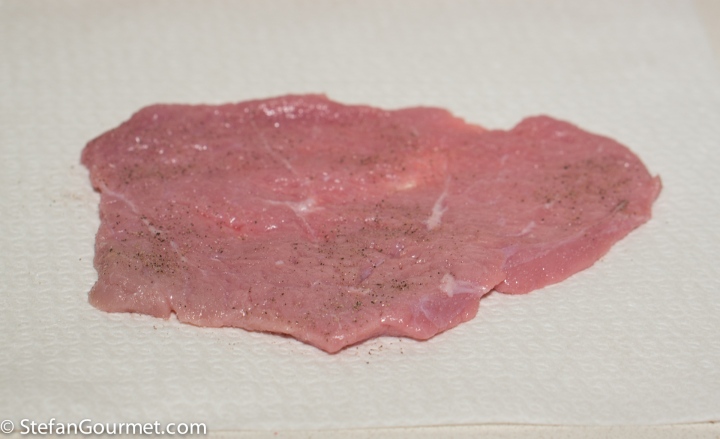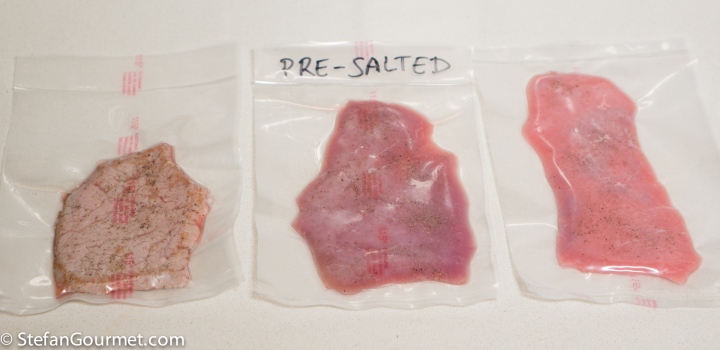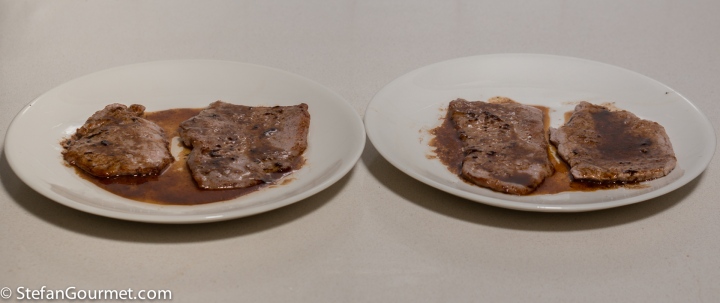Veal scaloppine is one of my favorite Italian secondi di carne (meat dishes) and I prepare it often. (Please note that the Italian singular is scaloppina, plural scaloppine. The American “scaloppini” is as wrong as talking about “one panini” (which is plural, the singular would be “panino”).) There are many variations in terms of the sauce (usually a pan sauce using for example marsala or balsamic vinegar), but they are always prepared the same: pan-fried very quickly. Veal scaloppine are thin slices of veal that are so thin (about 3 mm or 1/8 inch) that they require only about 30 seconds per side. If you cook them any longer, they will dry out and become tough. And so even though I have been cooking sous-vide for almost seven years now and prepare scaloppine often, I had dismissed the idea to prepare them sous-vide on a theoretical basis and had never tried it.
But since I like doing experiments and always like to be surprised by unexpected results, I thought there would be no harm in subjecting these 4 veal scaloppine to an experiment to see if cooking them sous-vide would turn out to be worthwhile in practice despite my theoretical misgivings.
And so I treated each of them differently:
- Was seasoned with salt and pepper, pre-seared for 20 seconds per side, then chilled, vacuum sealed, and cooked sous-vide for 15 minutes at 60C/140F
- Was seasoned with salt and pepper, vacuum sealed, allowed to rest for 2 hours in the refrigerator, cooked sous-vide for 15 minutes at 60C/140F, and then post-seared for 20 seconds per side
- Was seasoned with salt and pepper at the last minute, vacuum sealed, cooked sous-vide for 15 minutes at 60C/140F, and then post-seared for 20 seconds per side
- Was seasoned with salt and pepper, then seared for 30 seconds per side, and allowed to rest for 5 minutes (the classic preparation)
With these experiments I wanted to find out:
- If cooking scaloppine sous-vide is worth the trouble at all
- If pre-searing or post-searing would work better when cooking scaloppine sous-vide
- If pre-salting would make any difference
For all experiments the scaloppine were patted dry with paper towels and seasoned with salt and freshly ground black pepper.
For all experiments they were seared in clarified butter in a special frying pan by Demeyere that on induction can’t be heated above 220C/430F. By using full induction power I could therefore more or less guarantee that each scaloppina would be seared with equal force.
I used a timer and seared them for the same amount of time on each side. I chose to post-sear (and for comparison purposes also pre-sear) for only 20 seconds rather than the usual 30 seconds to reduce the risk of overcooking the scaloppine when post-searing. (As the sous-vide cooking had already brought them to a core temperature of 60C/140F and they are so thin, they are very susceptible to being overcooked and even 5 seconds more can make a difference in how done they will be.)
I made a pan sauce by pouring out the residual butter and deglazing the pan with marsala…
…and scraping the bottom of the pan with a wooden spatula to get all the browned bits into the sauce.
The pre-seared scaloppina was first allowed to cool to room temperature…
…and then to chill further in the refrigerator. Vacuum sealing a hot scaloppina would draw out the juices and would make this an unfair comparison.
The pre-seared, pre-salted, and regular scaloppina were all vacuum sealed and ready to go into the sous-vide.
When they came out, the pre-seared looked about the same but the others looked kind of greyish as is usual with sous-vide.
I patted the scaloppine that were to be post-seared dry with paper towels and allowed them to cool for about 5 minutes…
…before searing them for 20 seconds on each side in clarified butter.
I combined the pan sauce of all three batches…
…and then it was time to taste them!
The verdict
The post-seared scaloppine were clearly inferior to the scaloppina cooked the classic way and the pre-seared sous-vide scaloppina, because they were slightly overcooked. Apparently allowing them to cool for 5 minutes was not enough and so the post-searing caused them to be overcooked. I could not detect any difference between the pre-salted one and the other one, so the pre-salting did not make any difference (which is not surprising given how thin the scaloppine were).
The pre-seared scaloppina and the classic scaloppina were very similar. The pre-seared sous-vide scaloppina was slightly more tender than the classic scaloppina, and they were equally juicy. Even though this experiment has demonstrated that it is possible to cook scaloppine sous-vide with a result that is as good or perhaps even a bit better than the classic way (and that 15 minutes at 60C/140F is a good time and temperature to do this), I don’t think it is worth the additional trouble.
The only situation where I would recommend cooking scaloppine sous-vide is when you have to serve a large number of scaloppine at the same time, because then taking the time to pre-sear them in batches beforehand and being able to serve them by simply opening up the sous-vide bags would be useful.
Flashback

Roze koeken are very popular at Dutch highschool as a snack after (or instead of) a lunchbox full of sandwiches. The pink glaze on top of store-bought roze koeken looks and tastes a bit chemical, and it is. But if you don’t want to eat ground beetles, you could always bake them yourself.

















A classic!
LikeLiked by 1 person
Interesting stepping into your meat laboratory: thank you for going to all that trouble 🙂 ! Love scallopine made with all kinds of sauces atop . . . . and you know method four would be the one I would automatically use for the meat! Actually one of my favourite quick mid-week meals also . . .
LikeLiked by 1 person
Great post, very much in the Stefan style.
LikeLiked by 2 people
Interesting experiment.
It would be interesting, to see, what is tastier: a flattened cutlet (traditionally) – or a much thicker piece, but cooked sous vide for an extended amount of time to tenderize.
Further, it would be interesting when you are breading the “schnitzel” – having one thin one and a thick one which is sous vide.
LikeLiked by 1 person
Hi Stefan! I love that you take the chance to teach some Italian while sharing your recipe! Here in midwest “vitello” is almost impossible to find, and I missed it very much… your post made my mouth watering 😉! I also admire your propension to cooking experiments… the perfect way to find out new tastes and dishes! Good job!
LikeLiked by 1 person
Interesting experiment, but I’m glad to read that the traditional cooking way is the best. Did you ever try scaloppine “alla pizaiola” with tomato souces, olives, capers and anchovies?
LikeLiked by 1 person
Only with beef: https://stefangourmet.com/2013/07/12/carne-alla-pizzaiola/
LikeLiked by 1 person
oh sorry. Sometimes I use pig
LikeLiked by 1 person
Thank you for the detailed experiment. It gives me insight to what I am about to undertake. From this blog I have decided not to use the sous Vide. great blog thanks
LikeLiked by 1 person